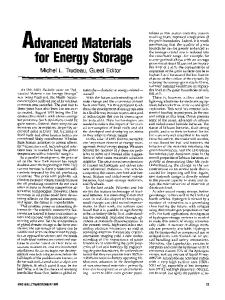Ruthenium Oxide Electrodeposition on Titanium Interdigitated Microarrays for Energy Storage
- PDF / 248,775 Bytes
- 6 Pages / 432 x 648 pts Page_size
- 31 Downloads / 317 Views
Ruthenium Oxide Electrodeposition on Titanium Interdigitated Microarrays for Energy Storage
K. Armstrong 1, T.M. Dinh 2, D. Pech 2, M. Brunet 2, J. Gaudet1 and D. Guay1 1
Institut National de la Recherche Scientifique, 1650 Blvd Lionel-Boulet, Varennes, QC, Canada J3X 1S2
2
Laboratoire d’Analyse et d’Architecture des Systèmes, LAAS-CNRS, 7 av du Colonel Roche, 31077 Toulouse Cedex 4, France.
ABSTRACT The electrodeposition of hydrated ruthenium dioxide (hRuO2) on Ti interdigitated current collectors deposited onto silicon substrate has been investigated with the objective of preparing a high capacitance and high power micro-supercapacitor (μ-SC) device. Ti current collectors were synthesised by typical photolithography processes, and hRuO2 thin films were electrodeposited from ruthenium chloride precursors. Device specific capacitances exceeding 20 mF·cm-2 were obtained, and more than 80 % of that value is retained even at scan rate as high as 1 V·s-1 in 0.5 M H2SO4. The mean specific power per active surface area of the device is 368 mW·cm-2. The device is stable and 90% of the initial capacity is retained after 105 cycles (1 V potential window). The characteristic response time of the hRuO2 μ-SC is 250 ms, with low ESR (0.61 Ω cm-2) and EDR (0.07 Ω cm-2) values. All these characteristics demonstrate the potential of such μ-SC devices to be part of the next generation of micro-supercapacitors. INTRODUCTION The development of low-power integrated circuits (such as sensors, microprocessors or wireless communication chips) has made wireless sensor networks increasingly popular in numerous applications such as transportation, medicine, environment and security. Consequently, it has led to a growing demand for compact energy storage elements integrated in the vicinity of the electronic circuit they are powering [1]. Micro-supercapacitor (μ-SC) can achieve this role, with their reversible energy storage capability, fast charge/discharge rates and outstanding lifetime (over a hundred thousands of cycles) [2]. An interesting avenue to fabricate such storage devices is to use planar interdigitated micro-electrodes, fabricated using conventional photolithography techniques [3] onto a Si substrate on which a pseudocapacitive material can be deposited. In this study, hydrated ruthenium dioxide (RuOx.nH2O, denoted hRuO2 thereafter) has been selected as pseudocapacitive material due to its metallic conductivity, the reversibility of the electrochemical redox reactions involved during the charging/discharging processes, and its chemical and thermal stability [2]. The energy density of this material is hundreds of times
265
higher than solid state or electrolytic capacitors [4]. Moreover, hRuO2 is readily deposited onto various substrates of different shapes, since many versatile techniques have already been identified in the literature [5]. The price of ruthenium could be considered as an obstacle to its widespread use; however, the small amounts of active material used in micro-devices result in ruthenium being only a mar
Data Loading...










